Abstract
Interest in the evolution of gonococcal auxotrophy led to a study of 72 strains isolated between 1935 and 1948 from the urogenital tract (57 patients), the eye (two patients), and from disseminated gonococcal infections (11 patients and probably two others). Two cervical isolates with nutritional requirements for proline, arginine, histidine, and biotin were oxidase-positive, Gram-negative diplococci, but their identity as Neisseria gonorrhoeae was uncertain because they were atypically susceptible to colistin and did not produce acid in glucose media. The N gonorrhoeae strains were highly susceptible to 11 other antibacterial drugs but not to sulphadiazine. Defects of one or more pathways for the biosynthesis of methionine, proline, arginine, threonine, lysine, the branched-chain amino acids, hypoxanthine, and thiamine pyrophosphate were found in 39 of the 70 strains, including four isolated in the presulphanilamide era. Unexpectedly, methionine was required for the growth of 11 (21%) of the 52 Danish strains and for 13 (72%) of 18 strains isolated in the USA. The Danish strains included 28 (54%) that did not require any of the compounds used for differentiating auxotypes, whereas this type was represented by only three (17%) of the USA strains. None of the gonococci required uracil or other pyrimidines. This suggests that the requirements for arginine, hypoxanthine, and uracil commonly found in recent isolates from disseminated gonococcal infections probably evolved treatment with sulphonamide was replaced by penicillin.
Full text
PDF
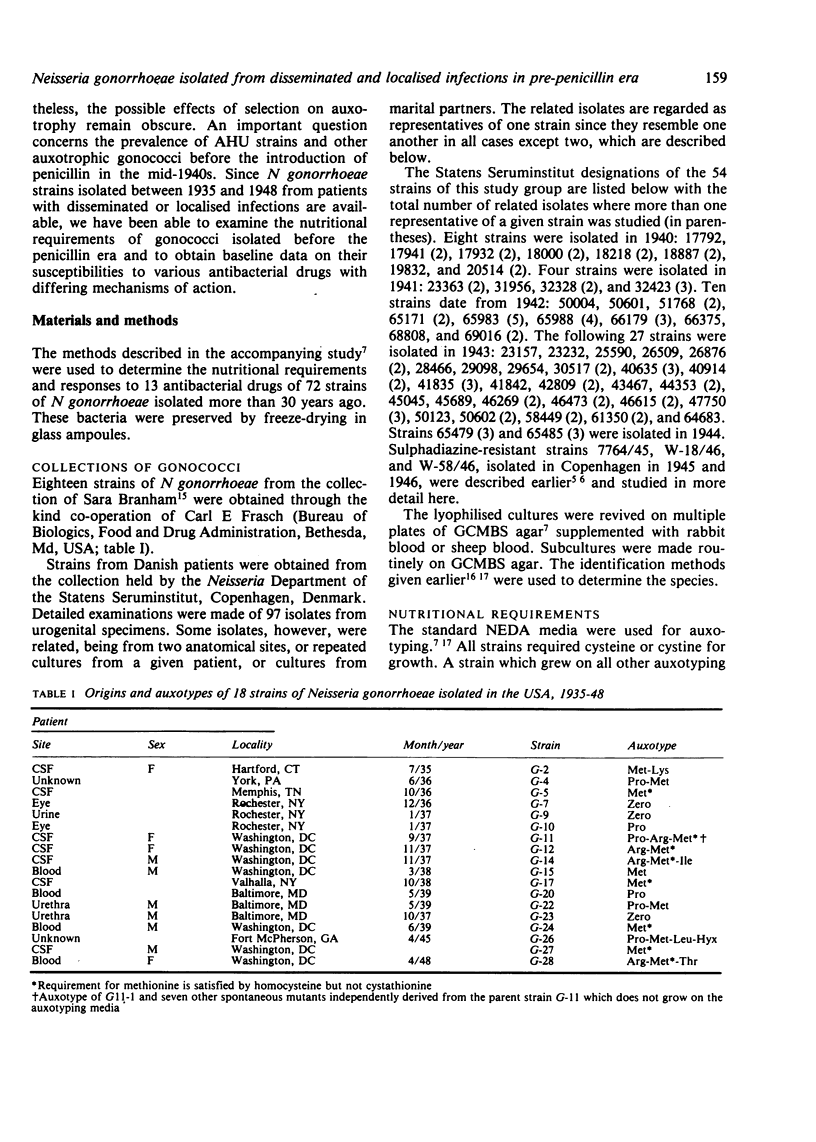
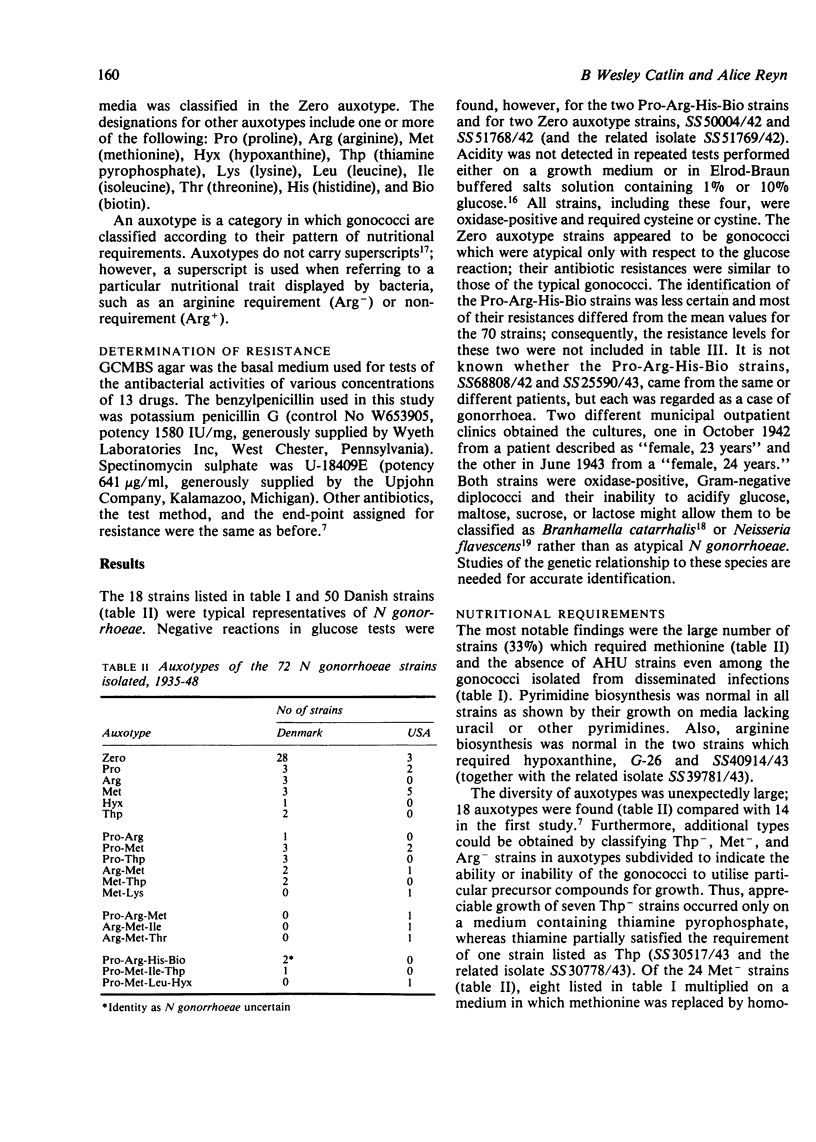
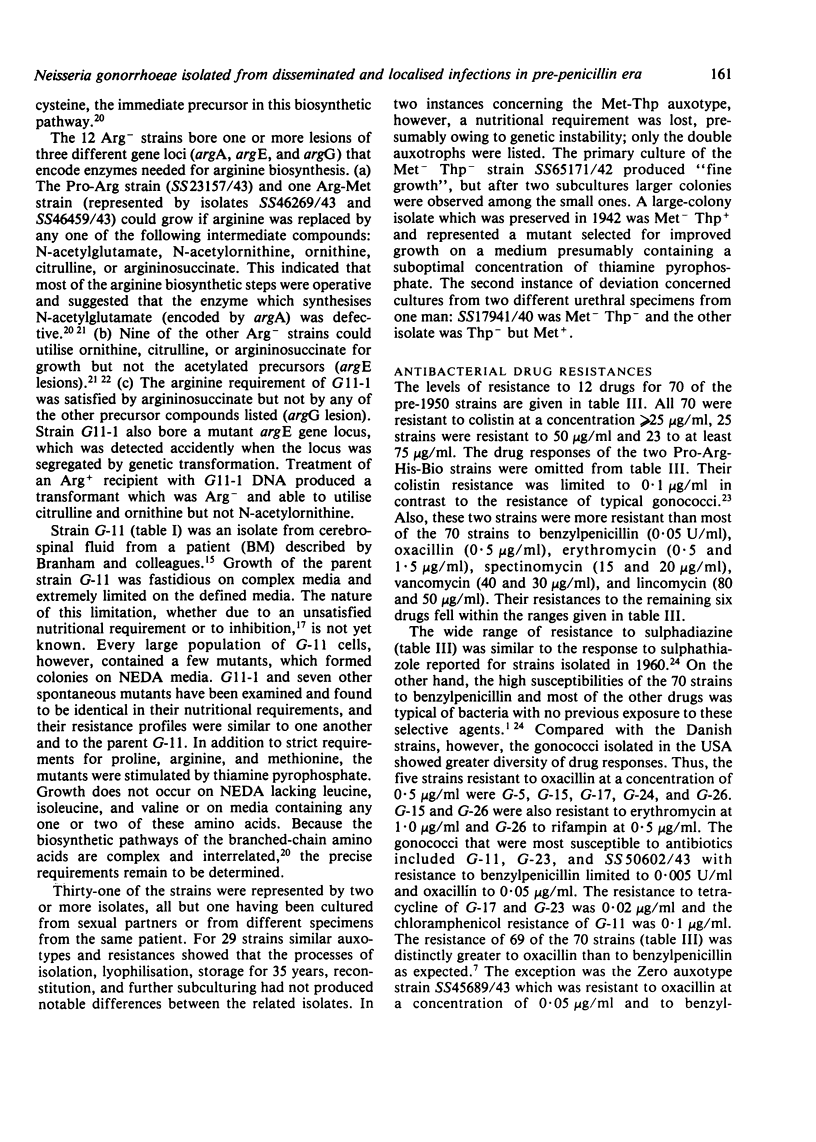

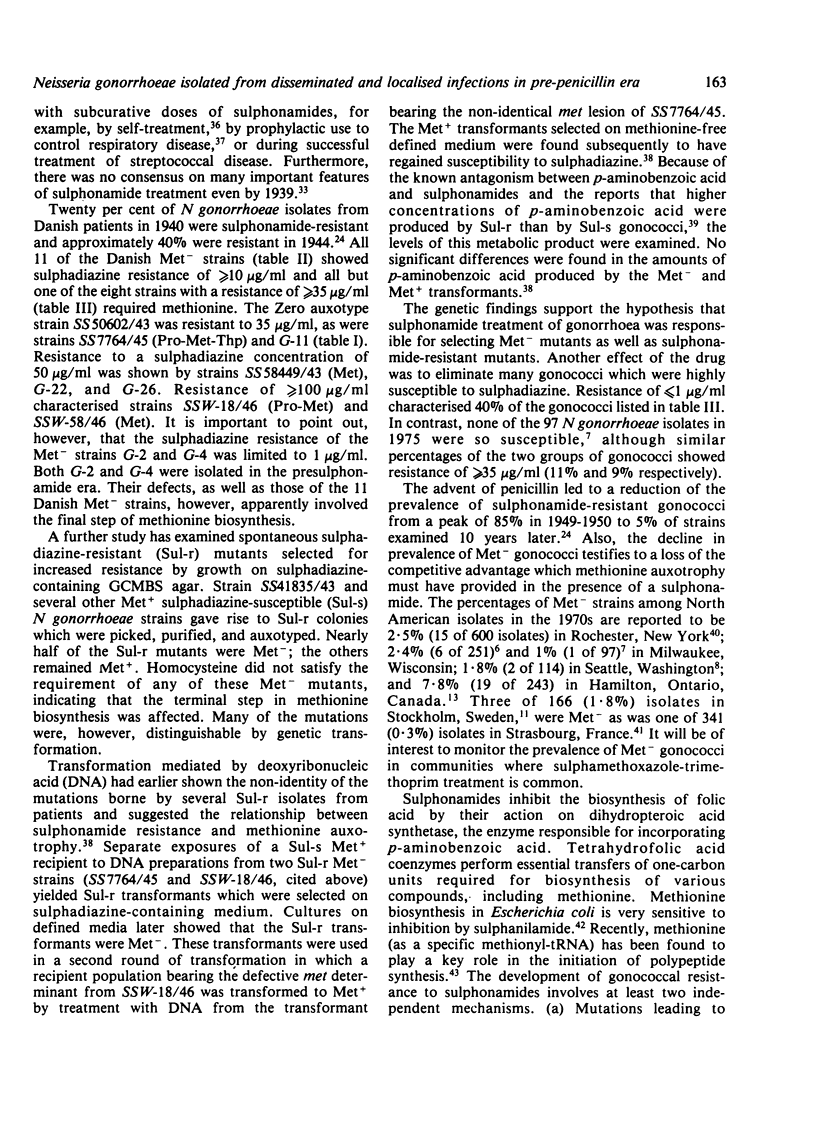

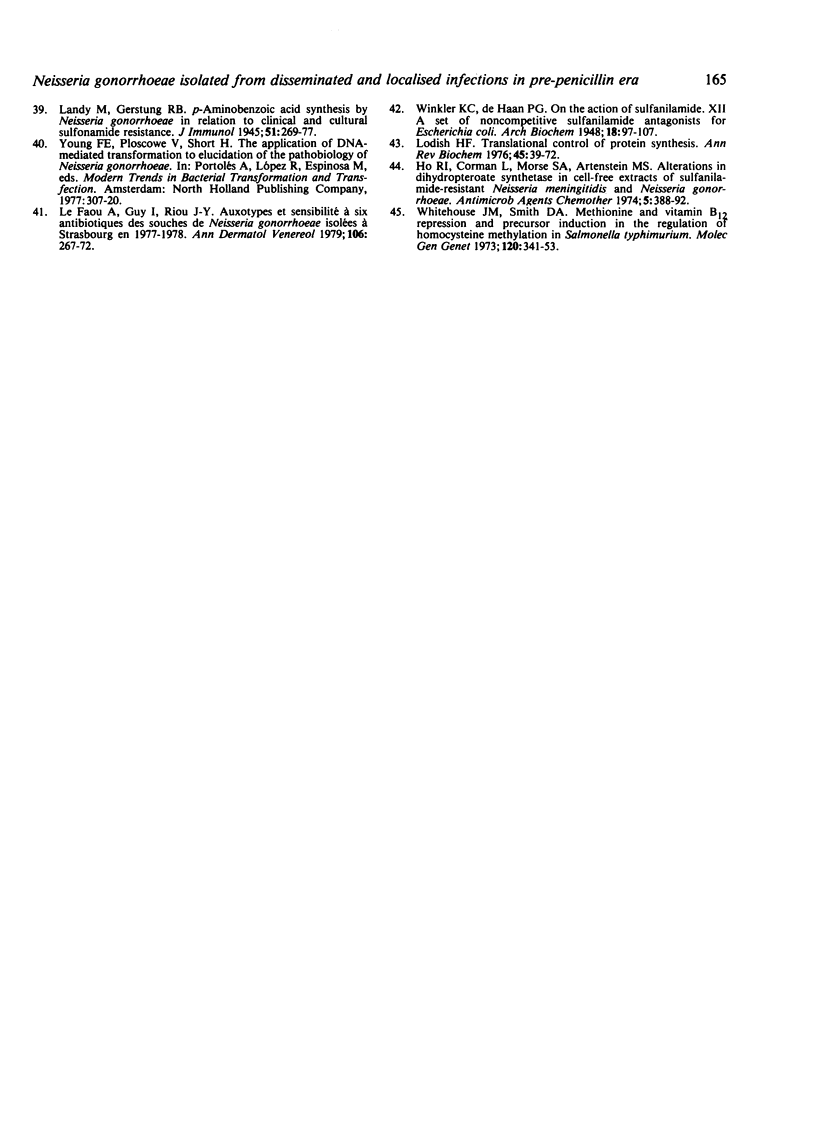
Selected References
These references are in PubMed. This may not be the complete list of references from this article.
- Carifo K., Catlin B. W. Neisseria gonorrhoeae auxotyping: differentiation of clinical isolates based on growth responses on chemically defined media. Appl Microbiol. 1973 Sep;26(3):223–230. doi: 10.1128/am.26.3.223-230.1973. [DOI] [PMC free article] [PubMed] [Google Scholar]
- Carpenter C. M., Ackerman H., Winchester M. E., Whittle J. Correlation of in vitro Sulfonamide Resistance of the Gonococcus with Results of Sulfonamide Therapy. Am J Public Health Nations Health. 1944 Mar;34(3):250–254. doi: 10.2105/ajph.34.3.250. [DOI] [PMC free article] [PubMed] [Google Scholar]
- Catlin B. W. Genetic studies of sulfadiazine-resistant and methionine-requiring Neisseria isolated from clinical material. J Bacteriol. 1967 Sep;94(3):719–733. doi: 10.1128/jb.94.3.719-733.1967. [DOI] [PMC free article] [PubMed] [Google Scholar]
- Catlin B. W. Nutritional profiles of Neisseria gonorrhoeae, Neisseria meningitidis, and Neisseria lactamica in chemically defined media and the use of growth requirements for gonococcal typing. J Infect Dis. 1973 Aug;128(2):178–194. doi: 10.1093/infdis/128.2.178. [DOI] [PubMed] [Google Scholar]
- DEMEREC M., HANSON J. Mutagenic action of manganese chloride. Cold Spring Harb Symp Quant Biol. 1951;16:215–228. doi: 10.1101/sqb.1951.016.01.017. [DOI] [PubMed] [Google Scholar]
- Eisenstein B. I., Lee T. J., Sparling P. F. Penicillin sensitivity and serum resistance are independent attributes of strains of Neisseria gonorrhoeae causing disseminated gonococcal infection. Infect Immun. 1977 Mar;15(3):834–841. doi: 10.1128/iai.15.3.834-841.1977. [DOI] [PMC free article] [PubMed] [Google Scholar]
- Exner A. C., Shinners E. N., Pace P. J., Catlin B. W. Auxotypes and antibacterial resistance to gonococci with differing susceptibilities to vancomycin. Br J Vener Dis. 1982 Jun;58(3):166–175. doi: 10.1136/sti.58.3.166. [DOI] [PMC free article] [PubMed] [Google Scholar]
- Hendry A. T., Stewart I. O. Auxanographic grouping and typing of Neisseria gonorrhoeae. Can J Microbiol. 1979 Apr;25(4):512–521. doi: 10.1139/m79-075. [DOI] [PubMed] [Google Scholar]
- Ho R. I., Corman L., Morse S. A., Artenstein M. S. Alterations in dihydropteroate synthetase in cell-free extracts of sulfanilamide-resistant Neisseria meningitidis and Neisseria gonorrhoeae. Antimicrob Agents Chemother. 1974 Apr;5(4):388–392. doi: 10.1128/aac.5.4.388. [DOI] [PMC free article] [PubMed] [Google Scholar]
- Knapp J. S., Holmes K. K. Disseminated gonococcal infections caused by Neisseria gonorrhoeae with unique nutritional requirements. J Infect Dis. 1975 Aug;132(2):204–208. doi: 10.1093/infdis/132.2.204. [DOI] [PubMed] [Google Scholar]
- Knapp J. S., Thornsberry C., Schoolnik G. A., Wiesner P. J., Homes K. K. Phenotypic and epidemiologic correlates of auxotype in Neisseria gonorrhoeae. J Infect Dis. 1978 Aug;138(2):160–165. doi: 10.1093/infdis/138.2.160. [DOI] [PubMed] [Google Scholar]
- Lankford C. E., Snell E. E. Glutamine as a Growth Factor for Certain Strains of Neisseria Gonorrhoeae. J Bacteriol. 1943 Apr;45(4):410–411. doi: 10.1128/jb.45.4.410-411.1943. [DOI] [PMC free article] [PubMed] [Google Scholar]
- Le Faou A., Guy I., Riou J. Y. Auxotypes et sensibilité a 6 antibiotiques des souches de Neisseria gonorrhoeae isolées a Strasbourg en 1977-1978. Ann Dermatol Venereol. 1979 Mar;106(3):267–272. [PubMed] [Google Scholar]
- Lodish H. F. Translational control of protein synthesis. Annu Rev Biochem. 1976;45:39–72. doi: 10.1146/annurev.bi.45.070176.000351. [DOI] [PubMed] [Google Scholar]
- Morello J. A., Lerner S. A., Bohnhoff M. Characteristics of atypical Neisseria gonorrhoeae from disseminated and localized infections. Infect Immun. 1976 May;13(5):1510–1516. doi: 10.1128/iai.13.5.1510-1516.1976. [DOI] [PMC free article] [PubMed] [Google Scholar]
- PERDRUP A. Gonorrhoea in Denmark. A survey of incidence over 82 years with comments on the reasons for the fluctuations noted. Br J Vener Dis. 1961 Jun;37:115–119. doi: 10.1136/sti.37.2.115. [DOI] [PMC free article] [PubMed] [Google Scholar]
- REYN A., KORNER B., BENTZON M. W. Effects of penicillin, streptomycin, and tetracycline on N. gonorrhoeae isolated in 1944 and in 1957. Br J Vener Dis. 1958 Dec;34(4):227–239. doi: 10.1136/sti.34.4.227. [DOI] [PMC free article] [PubMed] [Google Scholar]
- REYN A. Sensitivity of N. gonorrhoeae to antibiotics. Br J Vener Dis. 1961 Jun;37:145–157. doi: 10.1136/sti.37.2.145. [DOI] [PMC free article] [PubMed] [Google Scholar]
- Shinners E. N., Catlin B. W. Arginine biosynthesis in Neisseria gonorrhoeae: enzymes catalyzing the formation of ornithine and citrulline. J Bacteriol. 1978 Oct;136(1):131–135. doi: 10.1128/jb.136.1.131-135.1978. [DOI] [PMC free article] [PubMed] [Google Scholar]
- Thayer J. D., Martin J. E., Jr Improved medium selective for cultivation of N. gonorrhoeae and N. meningitidis. Public Health Rep. 1966 Jun;81(6):559–562. [PMC free article] [PubMed] [Google Scholar]
- Thompson S. E., Reynolds G., Short H. B., Thornsberry C., Biddle J. W., Jacobs N. F., Rein M. F., Zaidi A., Young F. E., Shulman J. A. Auxotypes and antibiotic susceptibility patterns of Neisseria gonorrhoeae from disseminated and local infections. Sex Transm Dis. 1978 Oct-Dec;5(4):127–131. doi: 10.1097/00007435-197810000-00001. [DOI] [PubMed] [Google Scholar]
- Umbarger H. E. Amino acid biosynthesis and its regulation. Annu Rev Biochem. 1978;47:532–606. doi: 10.1146/annurev.bi.47.070178.002533. [DOI] [PubMed] [Google Scholar]
- Willcox R. R. A survey of problems in the antibiotic treatment of gonorrhoea. With special reference to South-East Asia. Br J Vener Dis. 1970 Jun;46(3):217–242. doi: 10.1136/sti.46.3.217. [DOI] [PMC free article] [PubMed] [Google Scholar]


